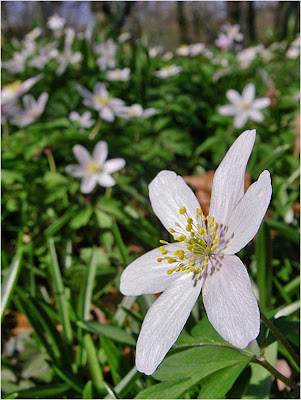Every autumn there are some fine specimens of fungi to be found growing in the Botanic Gardens and around the Science site. These fly agarics (Amanita muscaria) were growing amongst the birches near the stream on the southern edge of the Botanic Garden. Fly agaric forms a close mutually beneficial relationship with the roots of birch, helping the tree to acquire minerals like phosphorus from the soil in exchange for sugars provided by the tree.
These shaggy ink caps (Coprinus comatus) often appear in the grass beside the main road through the science site that leads to Mountjoy.
Within a few days of emergence ink caps begin to dissolve into a gooey mass of black spores, starting at the edge of the cap, until all that is left is a dark stain on the grass.
The university woodlands provide a wonderful habitat for fungi. These parasol mushrooms Lepiota procera (above and below) were growing in Little High Wood, just to the right of the infamous 'Cardiac Hill' that leads up to Biological Sciences.
Parasol mushrooms also turn up frequently in the Botanic Garden in autumn, associated with the cypresses growing on the conifer lawn. This one (below) is shaggy parasol Lepiota rhacodes, photographed earlier this week.

There are also some fine bracket fungi in the newly-opened nature trail in the woodland at the bottom of the Botanic Garden. These magnificent specimens of the bracket fungus Ganoderma adspersum, growing on a beech stump, were almost certainly the cause of the tree's death. This parasitic fungus weakens the tree and infected trunks typically snap somewhere above head height during gales. The fungus is perennial, so each year the bracket develops a new zone of spore-producing tissue around its periphery and generates so many spores that they cover the vegetation below with what looks like a layer of cocoa powder. You can estimate the age of the bracket by counting the number of ‘steps’ on its upper surface; each marks the end of a year’s growth. During their ten years of existence, these brackets must have produced billions of spores.


 This mini feeding station at the rear of the Health and Safety Service building on the Science Site has attracted 14 different species of birds ( and a squirrel). These photos show the commonest 3 visitors - from the top, great tit, blue tit and coal tit.
This mini feeding station at the rear of the Health and Safety Service building on the Science Site has attracted 14 different species of birds ( and a squirrel). These photos show the commonest 3 visitors - from the top, great tit, blue tit and coal tit.






















 Although the blackbird, mistle thrush (below) and song thrush can be seen all year round in Durham, our resident birds are joined by huge numbers that migrate here, like the fieldfare and redwing, and swell the local population during winter.
Although the blackbird, mistle thrush (below) and song thrush can be seen all year round in Durham, our resident birds are joined by huge numbers that migrate here, like the fieldfare and redwing, and swell the local population during winter. 



















